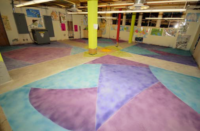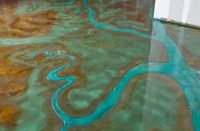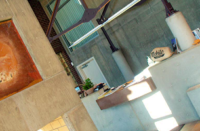 Zambon’s elegant and often intricate designs can be found in such high-profile Las Vegas venues as Caesars Palace, New York-New York and the MGM Grand, as well in a Tokyo shopping mall, a nightclub in Switzerland and PNC Park, home to the Pittsburgh Pirates.
Zambon’s elegant and often intricate designs can be found in such high-profile Las Vegas venues as Caesars Palace, New York-New York and the MGM Grand, as well in a Tokyo shopping mall, a nightclub in Switzerland and PNC Park, home to the Pittsburgh Pirates.
Zambon (her name is pronounced Michael Zam-BONE) racked up these high-end credits during her 11 years as a designer for arCon, a Las Vegas company that is no longer in business. It was unusual for a concrete company to hire a designer, let alone a designer who at the time knew nothing about concrete, but it turned out to be a fruitful move for everyone involved.
The artistry of arCon’s floors rose to new heights as Zambon, unburdened by preconceptions of what you can and can’t do with concrete, discovered that any pattern she could devise, no matter how complex, could be saw-cut or sandblasted into a floor. Zambon fell in love with the medium and found in it a profitable niche for her artistic talent.

In college, Zambon started out as an architecture student, but soon gravitated toward design, studying interior design, graphic design and even apparel design. Uncertain of which field she wanted to pursue, she took a break from the books to gain some real-world experience — a decision that led her to a field of design she hadn’t anticipated: concrete.
This twist of fate seems less surprising when you consider that her Italian-immigrant grandfather ran a terrazzo, tile and marble flooring shop in Houston. While Zambon wasn’t exactly born with kneeboards on, she certainly has decorative flooring in her blood.

In 2001, Zambon and her husband, Mike Anderson (who served as vice president of construction and general manager at arCon for five years), struck out on their own. Their company, artScape: Las Vegas, continues in the tradition of arCon, but on a smaller scale, concentrating on upscale residential and commercial jobs.
Listen in as she shares her experience with Concrete Decor magazine.
Where do the designs for your floors come from?
Everywhere and nowhere. I collect things that I find interesting in a four-inch thick binder: everything from area-rug patterns, color composition, border patterns, textile design and stained-glass designs. You never know what is going to inspire you or your client.
I saw an abstract geometric design on one of your floors that looks like it was inspired by the modernist painter Piet Mondrian, and I saw a bathroom that looked like it was inspired by the Flintstones, which raises the question: Who has influenced your work?
You obviously haven’t seen any of my Jetson’s-inspired work! Anyway, that’s why I keep my scrapbook of patterns and designs — you just don’t know what will inspire your next project. I like the simplistic lines of Mondrian, Mies van der Rohe and Corbusier, and got that exposure thanks to the architecture and graphics background. I love the detail in Frank Lloyd Wright stained glass panels. He is one of my favorite architects. Frank made concrete a respectable material inside a structure as well as out. He would love to see where it’s going today.
 How do you do those incredible woven patterns? Is that sort of a signature look of yours?
How do you do those incredible woven patterns? Is that sort of a signature look of yours?
It may have become a signature, but it started out as just an idea I liked. I love creating trompe l’oeil “area rugs,” and the first woven border I came across that inspired those was actually a recessed ceiling detail I found in a set of plans for Treasure Island.
Since then I’ve been obsessive about finding border details and patterns, which I horde in my book. I guess my signature, if you could call it that, is to create things in concrete or toppings that you can’t get in any other medium.
We all know stained concrete is not a cheap alternative to carpet. Far from it. When your competition is wood, stone, tile or terrazzo, you need to be able to give clients something they might not be able to get anywhere else.
Do you consider yourself an artist?
I have a very good friend that paints who I consider an artist. I don’t put myself in that category, but I love what I do, and hopefully it shows. My background as well as Mike’s makes us a good team. He owned his own construction company in Kansas City for years before coming to Las Vegas. While I get to focus on the end result, Mike has to figure out how to get there, price it, stage it, man it and coordinate it. Everyone has their own part, mine’s just more fun! It’s really the guys in the field who make us look good, though. We have been blessed with a group of employees who really care about what they do. They understand that we are only as good as our worst job, and they make us proud everyday. I can put it on paper, but if it doesn’t get done right on the job, none of that matters. It’s the attention to the littlest details that makes a difference.

Who are artScape’s clients?
End-users or designers who have looked at every other floor covering option that’s out there before choosing concrete — because it gives them something aesthetically and/or because it solves a particular problem that no other medium could.
What are some of the most notable jobs artScape has done so far?
As far as noteworthy names, we’ve done work for the Bellagio, the Mirage, Sunset Station, and Green Valley Ranch. We also just completed Bally’s porte cochere and 13,000 square feet at the Aqua Theater inside Wynn Las Vegas, (formerly La Reve). It’s the newest Cirque du Soleil show on the strip with a 360-degree theater surrounding an enormous, circular tank that functions as the “stage.”
Last fall Mapei asked us to come help design and install their new showroom in Milan, Italy, which was a lot of fun. We did over 120 samples before the final 22 were selected. The language barrier was somewhat of a challenge, and that English-Italian dictionary I brought was more tourist-related than construction terminology. I could order a mean plate of gnocchi, but I couldn’t get a four-inch hand grinder with a quarter-inch blade to save my life!
 Do your clients usually know what they want before you come in, or do you work with them to develop a concept?
Do your clients usually know what they want before you come in, or do you work with them to develop a concept?
I think they are becoming more educated on the product, but rarely do they understand all the possibilities. One of the best things you can ask a client is what they DON’T want.
What are the most popular looks these days?
To me, they still remain more conservative and timeless, which I think they have to be. It’s not like buying a trendy couch that when the trend is over, you replace it. These floors are a big investment and you want the design to stand the test of time.
Many of your floors incorporate inlaid glass, wood, stone and other objects. What precautions do you take so your inlays don’t pop out?
I love mixing media. I think that stained concrete has a wonderfully earthy feel which natural stones or wood complement, and which glass mosaics or metallic inlays nicely contrast. Inlays just make the floor that much more interesting, and then those inlay materials can be used on backsplashes or countertops to pull the entire space together. We’ve never done anything specific to make sure inlays don’t pop out other than using the proper setting material specific to the product and caulking them after the fact in case the inlay expands or contracts at a different rate than the concrete with ambient moisture or temperature.
 What are your favorite tricks of the trade?
What are your favorite tricks of the trade?
Anyone who’s done stains will tell you that you are not the master of your trade — stains react however they want to on any given day. The best you can hope for when things don’t react the way they did on the sample that you got approved is to have a level of experience in knowing how to fix them.
What do you not like to see done with decorative concrete?
PAINT!
What plans do you have for the future?
Just recently we have formed a new company with Ken Aeschliman and Clint Walcott, called Architectural Stains Inc. It will be strictly union, to handle any casino work on the strip, as well as become the Bomanite licensee for Las Vegas. artScape will return to non-union residential and small commercial work.
If you had an opportunity to say something to 50,000 concrete contractors, what would you say?
Have pride in what you do and enjoy what you do. It will always show in the end product.












